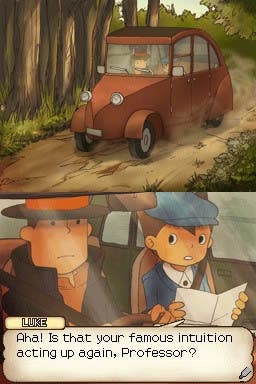Professor Layton and the Curious Village
Curiouser and curiouser.
The title is enough to let you know everything about this game. It's gorgeous, elaborate, and silly. It's a game that can only work on the DS, and celebrates all that's engaging and esoteric about the medium.
Professor Layton is a top-hat-wearing fellow who has a penchant for puzzle-solving. He has heard word about a mysterious village containing a special puzzle revolving around an object called The Golden Apple. Travelling with his young companion, Luke, he enters the curious village to discover a town populated by people obsessed with puzzles, and a lot of peculiar secrets. It's a puzzle game, but with one heck of a story.
At first glance, you'll think this is a kids' game. In fact, the opening sequence - a really beautiful animated cut-scene that you'd believe could have come from the mind of Hayao Miuazaki - really feels aimed at children. Prof Layton is an avuncular fellow, cheery of disposition and speaks very clearly and plainly to his buddy. Luke is a chirpy, over-enthusiastic kid, excited by the adventure laying out before them. It doesn't prepare you for a story that's surprisingly dark (there's a murder within the first hour), and then impressively convoluted. And perhaps most significantly, the puzzles are far too difficult for a pre-teen audience. Quickly you realise that your brain was just in the wrong place, and you soon settle into a cartoon world designed for adults.
As I type, I'm still playing the game. I've finished it, which unlocked some new puzzles for me. I then went back through to find a couple of puzzles I'd missed. Completing these, I've now unlocked three further puzzles. So I'm going to complete them before I carry on. Priorities, you see.
There, finished. Every puzzle (all 135) in the game completed. And I'm a better person for it. It took about 15 hours too.

This is how it works. You have this morbid and sweet story, involving murders, kidnappings, evil cowled figures, mysterious towers and hidden treasures, as a framework for a collection of superb brainteasers. Is there an internal coherence for everyone you meet stopping you in your hurried tracks and demanding that you work out how many squares can be arranged on a board of pegs, or which of the four people are telling lies in a story? Yes. There is. In fact, a recent Penny Arcade strip betrayed an ignorance of the game by mocking it for this - something that not only does the game mock itself for throughout, but then absolutely justifies with its story by the end.
It's all played with the stylus. You explore scenes and change location in a sort of point-and-click way (although your characters are rarely on screen for this), searching through each scene to find hidden clue coins (exchanged for clues when you're stuck in puzzles, but designed as a semi-limited resource to stop you cheating your way through) and secret puzzles. Characters are tapped on to talk to them, invariably resulting in their giving you a puzzle. And the overriding story encourages you to get to the next tale-telling locale (although after the first section, you can ignore these and explore at your leisure). Puzzles are also stylus-based, very often requiring you to draw on the screen, circle an object, or enter numbers and words through a superb handwriting recognition system.
It's originally a Japanese game, made by Level-5, who you might know from Rogue Galaxy, Dark Cloud or Dragon Quest VIII, released last year. But the large gap for translation and localisation has been entirely worth it. There isn't a missed beat; it's perfectly translated, and superbly reshaped. Japanese-centric puzzles, especially those featuring kanji, have been replaced with Western equivalents. Level-5's RPG background shines through, never subverting the game from what it is - an adventure/puzzle game - but demonstrating a talent for telling a good story. That you can't skip their cut-scenes is a stupid decision, but the first time you see them you'd be insane to want to.
So here's a couple of examples of the sorts of puzzles. Consider this a form of demo:
"The following is written on a piece of paper you picked up:
"_ is 1,000 times _ _'
To turn this strange message into a proper sentence, all you need to do is fill in the _ with a single letter of the alphabet. But what could the letter be? You'll need to use the same letter for all three _s."


